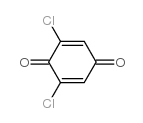2,6-DICHLORO-1,4-BENZOQUINONE

2,6-DICHLORO-1,4-BENZOQUINONE structure
|
Common Name | 2,6-DICHLORO-1,4-BENZOQUINONE | ||
|---|---|---|---|---|
| CAS Number | 697-91-6 | Molecular Weight | 176.98500 | |
| Density | 1.56g/cm3 | Boiling Point | 241.5ºC at 760 mmHg | |
| Molecular Formula | C6H2Cl2O2 | Melting Point | 122-124 °C(lit.) | |
| MSDS | Chinese USA | Flash Point | 98.5ºC | |
| Symbol |

GHS07 |
Signal Word | Warning | |
| Name | 2,6-Dichloro-1,4-benzoquinone |
|---|---|
| Synonym | More Synonyms |
| Density | 1.56g/cm3 |
|---|---|
| Boiling Point | 241.5ºC at 760 mmHg |
| Melting Point | 122-124 °C(lit.) |
| Molecular Formula | C6H2Cl2O2 |
| Molecular Weight | 176.98500 |
| Flash Point | 98.5ºC |
| Exact Mass | 175.94300 |
| PSA | 34.14000 |
| LogP | 1.38360 |
| Index of Refraction | 1.568 |
| InChIKey | JCARTGJGWCGSSU-UHFFFAOYSA-N |
| SMILES | O=C1C=C(Cl)C(=O)C(Cl)=C1 |
CHEMICAL IDENTIFICATION
HEALTH HAZARD DATAACUTE TOXICITY DATA
|
| Symbol |

GHS07 |
|---|---|
| Signal Word | Warning |
| Hazard Statements | H315-H319-H335 |
| Precautionary Statements | P261-P305 + P351 + P338 |
| Personal Protective Equipment | dust mask type N95 (US);Eyeshields;Gloves |
| Hazard Codes | Xi |
| Risk Phrases | 36/37/38 |
| Safety Phrases | S26-S36 |
| RIDADR | NONH for all modes of transport |
| WGK Germany | 3 |
| RTECS | DK4000000 |
| HS Code | 2914700090 |
| HS Code | 2914700090 |
|---|---|
| Summary | HS: 2914700090 halogenated, sulphonated, nitrated or nitrosated derivatives of ketones and quinones, whether or not with other oxygen function Tax rebate rate:9.0% Supervision conditions:none VAT:17.0% MFN tariff:5.5% General tariff:30.0% |
|
Metal-independent decomposition of hydroperoxides by halogenated quinones: detection and identification of a quinone ketoxy radical.
Proc. Natl. Acad. Sci. U. S. A. 106(28) , 11466-71, (2009) We have shown recently that halogenated quinones could enhance the decomposition of hydroperoxides and formation of alkoxyl/hydroxyl radicals through a metal-independent mechanism. However, neither th... |
|
|
Removal of halo-benzoquinone (emerging disinfection by-product) precursor material from three surface waters using coagulation.
Water Res. 47(5) , 1773-82, (2013) Halo-benzoquinones (HBQs) have been previously detected as disinfection by-products in chlorinated drinking water. The current work investigates the link between natural organic matter (NOM) character... |
|
|
Microbial anaerobic demethylation and dechlorination of chlorinated hydroquinone metabolites synthesized by basidiomycete fungi.
Appl. Environ. Microbiol. 70(1) , 385-92, (2004) The synthesis and degradation of anthropogenic and natural organohalides are the basis of a global halogen cycle. Chlorinated hydroquinone metabolites (CHMs) synthesized by basidiomycete fungi and pre... |
| MFCD00037159 |
| 2,6-dichlorocyclohexa-2,5-diene-1,4-dione |
| EINECS 211-810-0 |